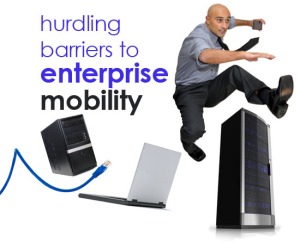 My topic shifts now from availability to mobility. This means that I will treat everything which comes along with Enterprise Mobility the next weeks. This week I begin with a Introduction into that sphere. Enterprise Mobility , a word which became a hotshot in every big-company-managements vocabulary, top of mind for a lot of IT leaders at companies everywhere and means the trend toward a shift in work habits, with more employees working out of the office and using mobile devices and cloud services to perform business tasks. Your employees and customers are mobile, which means your business processes must also be mobile.
My topic shifts now from availability to mobility. This means that I will treat everything which comes along with Enterprise Mobility the next weeks. This week I begin with a Introduction into that sphere. Enterprise Mobility , a word which became a hotshot in every big-company-managements vocabulary, top of mind for a lot of IT leaders at companies everywhere and means the trend toward a shift in work habits, with more employees working out of the office and using mobile devices and cloud services to perform business tasks. Your employees and customers are mobile, which means your business processes must also be mobile.
“Enterprise mobility is about giving the company itself (not just individuals within the company) the tools and technologies to do business anyplace, anytime, anywhere.” – Christopher Glenn, 2010
Check out this amazing video which is explaining Enterprise Mobility in an easy way.
Don´t confuse Enterprise Mobility with the term “mobility technology” because it is not only a mobile cell phone connection but moreover it includes wireless IP networks, managed services, cloud computing, and social media. All of these things play a role in enabling the anyplace, anytime, anywhere aspirations of a company.
AT&T Model
In september 2012, the American company AT&T outlined four distinct phases of enterprise mobility in an educational event. Visitor Maribel Lopez, elaborated on the 4 phases of Enterprise Mobility in her article which was published in September, 2012´s Forbes online magazine. The phases are:
- Informal. No formal process is in place and most initiatives are personal efforts or based on requests from various executives.
- Silos. In phase two, different divisions plan and execute separate initiatives that may overlap.
- Coordinated. In this phase, enterprise standards exist but divisions are free to plan and execute their own initiatives, as long as the initiatives adhere to the company standard.
- Integrated. In the final phase, initiatives are based on a formal enterprise strategy and roadmap. Initiatives are planned, executed and monitored centrally.
The biggest problem about this enterprise mobility is the security aspect. Every employee, wherever he is, carries all the sensitive business data within his/her mobile office. Due to that many providers offer Enterprise Mobility Management solutions. I will introduce you them them in my next week´s blog! Thanks for reading!
